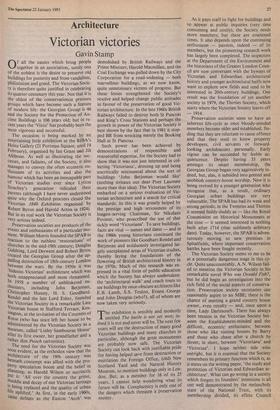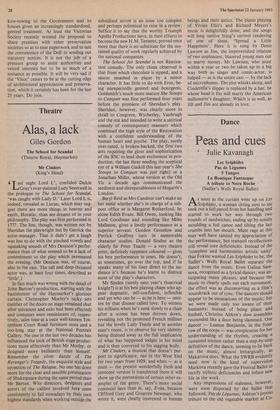Architecture
Victorian victories
Gavin Stamp
(--,%f all the causes which bring people V together in an association, surely one of the noblest is the desire to preserve old buildings for posterity and from vandalism, Philistinism and greed. The Victorian Socie- ty is therefore quite justified in celebrating its quarter-centenary this year. Not that it is the oldest of the conservationist pressure groups which have become such a feature of modern life: the Georgian Group is 46 and the Society for the Protection of An- cient Buildings is 106 years old; but in re- cent years the Vixoc' has probably been the most vigorous and successful. The occasion is being marked by an entertaining little exhibition at the RIBA's Heinz Gallery (21 Portman Square; until 19 February), organised by Ian Grant and Jill Allibone. As well as illustrating the suc- cesses, and failures, of the Society, it also manages to convey the often eccentric en- thusiastn of its activities and also the humour which has been an inescapable part of Victorian studies ever since Lytton Strachey's generation ridiculed their Parents (although I have never understood quite why the Oxford proctors closed the Victorian 1840 Exhibition, organised by Robert Byron and Harold Acton in 1924). But in its real work the Victorian Society is very serious indeed. Preservation societies are products of the events and enthusiasms of a particular mo- ment. William Morris founded the SPAB in reaction to the ruthless 'restorations' of churches in the mid-19th century; Douglas Goldring, Lord Derwent and Robert Byron created the Georgian Group after the ap- Palling destruction of 18th-century London between the wars. By the 1950s it was hideous Victorian' architecture which was both unappreciated and most threatened. In 1958 a number of unblinkered en- thusiasts, including John Betjeman, Christopher Hussey, H. S. Goodhard- Retidel and the late Lord Esher, founded the Victorian Society in a remarkable Late Victorian house in Stafford Terrace, Ken- sington, at the invitation of the Countess of Rosse (who has since left her house to be administered by the Victorian Society as a museum, called Linley Sambourne House' after its first owner, her grandfather and a rather dim Punch cartoonist). The need for the Victorian Society was soon evident, as the orthodox view that the architecture of the 19th century was beneath contempt was allied with the pro- perty speculation boom and the belief in Planning; as Harold Wilson so succinctly Put it: 'All over the country the grime, Muddle and decay of our Victorian heritage is being replaced and the quality of urban life uplifted.' At first, in the early 1960s, came defeats as the Euston 'Arch' was demolished by British Railways and the Prime Minister, Harold Macmillan, and the Coal Exchange was pulled down by the City Corporation for a road-widening — both marvellous buildings, as we now know, quite unnecessary victims of progress. But these losses strengthened the Society's resolve and helped change public attitudes in favour of the preservation of good Vic- torian architecture. In the late 1960s British Railways failed to destroy both St Pancras and King's Cross Stations and perhaps the growth in power of the Victorian Society is best shown by the fact that in 1981 it stop- ped BR from wrecking merely the Booking Hall at St Pancras. Such power has been achieved by demonstrations of responsible and resourceful expertise, for the Society had to show that it was not just interested in col- lecting `Victoriana', dressing up and being uncritically sentimental about the sort of buildings 'John Betjeman would like' (nothing irritates our dear Poet Laureate more than that idea). The Victorian Society embarked on a serious evaluation of Vic- torian architecture and a search for critical standards. In this it was greatly helped by the prestige and high seriousness of its longest-serving Chairman, Sir Nikolaus Pevsner, who proscribed the use of that sickly word Victoriana' . To save buildings, facts are vital — names and dates — and in the 1960s young historians continued the work of pioneers like Goodhart-Rendel and Betjeman and assiduously investigated lar- gely unexplained areas of Victorian studies, thereby laying the foundations of the flowering of British architectural history in the 1970s. Much of this research was ex- pressed in a vital form of public education which the Society has always undertaken: the 'architectural walk' and coach tours to see buildings by once-obscure architects like E.B. Lamb, S.S. Teulon, Ernest George and John Douglas (who?), all of whom are now taken very seriously. The exhibition is sensibly and modestly entitled The battle is not yet won; in- deed it is not and never will be. The next few years will see the destruction of many good Victorian buildings and many churches in particular, although the great monuments are probably now safe. The Victorian Society can look back with justifiable pride for having helped save from destruction or mutilation the Foreign Office, (old) New Scotland Yard and the Natural History Museum, to mention buildings only in Lon- don. But, as a member for 16 of its 25 years, I cannot help wondering what its future will be. Complacency is only one of the dangers which threaten a preservation society. As it pays staff to fight for buildings and to appear at public inquiries (very time consuming and costly), the Society needs more members; but these are straitened times. It also depends upon the continuing enthusiasm -- passion, indeed — of its members, but the pioneering research work has largely been completed. The inspectors at the Department of the Environment and the historians of the Greater London Coun- cil are now conversant with the byways of Victorian and Edwardian architectural history and younger architectural buffs now want to explore new fields and tend to be interested in 20th-century buildings. One result was the foundation of yet another society in 1979, the Thirties Society, which starts where the Victorian Society leaves off — 1914. Preservation societies seem to have an inherent life-cycle as once bloody-minded members become older and established, fin- ding that they are reluctant to cause offence and that they tend to know property developers, civil servants or forward- looking archdeacons personally. Early vigour can be succeeded by feeble ac- quiescence. Despite having 33 peers amongst its smart membership, the Georgian Group began very aggressively in- deed, but, alas, it subsided into genteel and snobbish country-house worship. Now it is being revived by a younger generation who recognise that, as a result, ordinary Georgian urban buildings are very vulnerable. The SPAB has had its weak and strong periods; in the Twenties and Thirties it seemed fuddy-duddy as — like the Royal Commission on Historical Monuments at the time — it seemed interested in nothing built after 1714 (that sublimely arbitrary date). Today, however, the SPAB is adven- turously moving to new premises in Spitalfields, where important conservation battles have been fought recently. The Victorian Society seems to me to be at a potentially dangerous stage in this cy- cle. Quite unaccountably, A.N. Wilson fail- ed to mention the Victorian Society in his remarkable novel Who was Oswald Fish?, but he did begin an investigation into the rich field of the social aspects of conserva- tion. Preservation society secretaries can reasonably aspire to an MBE; there is the chance of meeting a grand country house owner, even royalty — and, once upon a time, Lady Dartmouth. There has always been tension in the Victorian Society bet- ween the Establishment-minded and the difficult, eccentric enthusiasts; between those who like visiting houses by Barry and those who chase after a church by Street; in short, between Nictoriana' and `Victorian'. I hope neither side wins outright, but it is essential that the Society remembers its primary function which is, as it states on the writing paper, 'the study and protection of Victorian and Edwardian ar- chitecture'. What can go wrong in a society which forgets its founders' intentions is all too well demonstrated by the melancholy state of the National Trust, with its membership divided, its effete Council
kow-towing to the Government and its houses given an increasingly standardised, genteel treatment. At least the Victorian Society recently resisted the proposal to share premises with other preservation societies so as to ease paperwork and to suit the convenience of the DoE in sending out statutory notices. It is not the job of a pressure group to assist authorities and vested interests but to be as much of a nuisance as possible. It will be very sad if the `Vixoc' ceases to be at the cutting edge of architectural appreciation and preserva- tion, which it certainly has been for the last 25 years. Do join.







































 Previous page
Previous page